| American
Whiskey
February 23, 2001 -- The Bluegrass Parkway East: Kentucky
|
|||
If you're reading all of these pages, you might think there's been a mistake
here. Much of what you'll read on this page looks awfully similar to our
visit and tour of the Leestown Distillery,
home of Ancient Age, Blanton’s, Elmer T. Lee, and several
other products. That's because this is the same distillery. It's known
as Buffalo Trace now.
The tour they give here is still the best of the large plants, but we won't
be taking the public tour this time. Actually, we have taken the public tour
since the change to Buffalo Trace, but this time is very different. We are
here as the personal guests of Sazerac Bourbon Brand Manager Ken Weber and
two of his finest, Jim Locker and Sandy Goins.
We arrive at 9:00 and say hello to Wally, the gate guard. He sees so many
people we don't expect him to remember us, and he doesn't. But we remember
him. We know exactly where he'll tell us to park, but we quickly discover
the first of the changes; the tours now begin and end in a gift shop and
tasting bar.
Ken arrives, looking younger than we expected (a man in his position probably hates hearing that; oh well...) and shortly afterward Sandy Goins. Excuse me, that's Colonel Sandy Goins. Now, in Kentucky you're likely to find many distinguished citizens with the title "Colonel" (Harlan Sanders being a very well-known example). The civilian title of Colonel is semi-legitimate in Kentucky, which is to say that it isn't a valid military rank, but it is a valid honorary designation given by the governor and it is neither given nor taken lightly. Sandy is a Kentucky Colonel. He is also an Arkansas Colonel, which is a similar designation. But he is also a true U.S. Army (retired) colonel as well. At least Ken says so, and he sure acts like we'd expect a retired Army colonel to act. A balance of down-home and royal dignity. You see a lot of that in Kentucky people; it's one of the things we love most about them.
We begin the first part of the tour. Since we've done this several times
before, we skip the video about how bourbon is made, but if you take this
tour you really shouldn't miss it. Ken is, of course, quite familiar with
all the elements of the tour, but he doesn't normally act as tour guide.
That's Jim's job, and for the most part Ken lets him do it. We, however,
tend to treat the whole thing as just five friends walking around the distillery
where three of them
work.
Of course, we talk a lot about the history of Buffalo Trace. The current
company is still in transition, and undergoing a major identity crisis. The
new management (which is really a portion of the old management who have
now gained control) want desperately to establish an image of their own.
The difficulty is that they are the same folks who so successfully established
the very brands they now are trying to replace. If they hadn't been so good
at what they do, it would be a lot easier, but customers who have become
die-hard fans of Rock Hill Farms, Blanton's,
Other than a new coat of paint, the distillery doesn't look much different.
The mural of the barrel warehouse, with its eerie perspective that makes
it look like the door on the other end of the room is following you as you
pass, is still there. Except that now it says Buffalo Trace instead of Ancient
Age. And, even though the tours no longer begin and end there, the
employees’ clubhouse and cafeteria, a huge, almost Scandinavian-looking
log house overlooking a beautifully landscaped park and grounds is still
in daily use. There is also a matching (though smaller, of course) guest
house nearby.
It was a beautiful old sycamore tree, one of several that dotted the hillside
leading up to the mansion. And it stood for many many years, until a lightning
bolt split and destroyed it. They had to have it cut down. When they next
looked at it, they were shocked to see the tree surgeons had left a stump
several feet high.
Of course, much of our interest in this tour has to do with the history of
Buffalo Trace, as it has been the home of much bourbon history. When the
first Americans knew it, Kentucky was a place where people came to hunt.
Native tribes didn't live here, but many different ones sought the buffalo
that did. And long before there was a Frankfort, or a Leestown, this particular
area was part of a major path of migration for buffalo. It was here that
their trail (or "trace") crossed a shallow part of the Kentucky River. And
this was a good location for settlement, which is what Hancock McAfee and
Willis Lee established in 1775.
The first tour is great, but the second is even better. For this one we put on special hard-hats to protect us as we climb around the catwalks and ladders in the main distillery building. We have a chance to smell, taste, and compare freshly distilled low wine, bourbon that has just come off the main still, with true white dog as it comes from the doubler, ready to be put into the barrels. We also get a chance to see parts of the distillery no one ever gets to see, as the three guides manage more than once to lose track of how to get from one place to another. John is reminded of scenes from the movie, Goonies where the kids are climbing through the tunnels.
Back at the gift shop, we turn in our green hardhats and thank our hosts for a really wonderful morning spent learning how one of the most important bourbon distilleries in the world works.
|
 |
|
Story and original photography
copyright ©2001 by John F. Lipman. All rights reserved. |

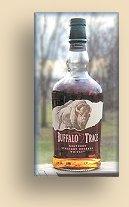 They
still market those brands, and some others have been introduced as well.
They
still market those brands, and some others have been introduced as well.
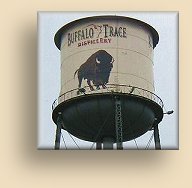 They will be taking us for not one but two tours.
The first will be a customized version of the regular public tour, and the
second will be what they call a "hard-hat" tour which is far more involved.
We first met Ken electronically, as members of an internet bourbon discussion
group and he extended his kind invitation to come see what changes have been
made to the old Ancient Age place.
They will be taking us for not one but two tours.
The first will be a customized version of the regular public tour, and the
second will be what they call a "hard-hat" tour which is far more involved.
We first met Ken electronically, as members of an internet bourbon discussion
group and he extended his kind invitation to come see what changes have been
made to the old Ancient Age place.
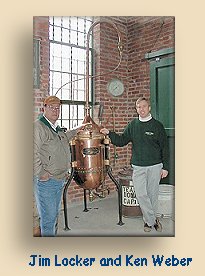 The old tour also did that, but this is in a different
building. Here we meet Nancy Gum, who runs the gift shop, and also Jim Locker,
who is waiting for us and Ken to show up. Actually, the gift shop isn't really
the first change we notice; we could hardly miss the famous Ancient Age water
tower, which now sports the Buffalo Trace name and logo.
The old tour also did that, but this is in a different
building. Here we meet Nancy Gum, who runs the gift shop, and also Jim Locker,
who is waiting for us and Ken to show up. Actually, the gift shop isn't really
the first change we notice; we could hardly miss the famous Ancient Age water
tower, which now sports the Buffalo Trace name and logo.
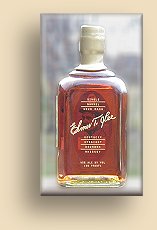
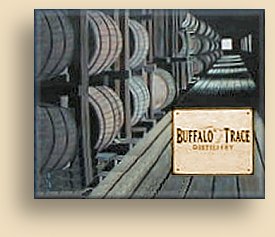 Hancock's Reserve, and Ancient Ancient Age are reluctant
to switch over to Buffalo Trace or Eagle Rare, or especially to Old Charter
or Weller, brands that were once competitors from another distillery. And
since all the custody battles are not yet completely over, the new management
can hardly be blamed for hesitating to promote brands they don't already
own 100% of. Those of us who love both the old brands and the new ones can
hardly wait for the dust to settle.
Hancock's Reserve, and Ancient Ancient Age are reluctant
to switch over to Buffalo Trace or Eagle Rare, or especially to Old Charter
or Weller, brands that were once competitors from another distillery. And
since all the custody battles are not yet completely over, the new management
can hardly be blamed for hesitating to promote brands they don't already
own 100% of. Those of us who love both the old brands and the new ones can
hardly wait for the dust to settle.
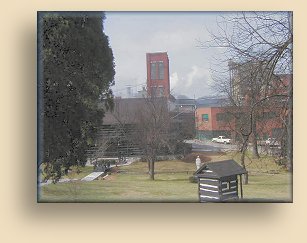 This all appears to be part of the property of Col.
Albert Blanton, the distillery’s founder, whose stone mansion stands
at the top of the hill overlooking everything. His statue still stands near
a stream in the park. But it is now joined by an even more impressive artwork.
You see, they had this tree...
This all appears to be part of the property of Col.
Albert Blanton, the distillery’s founder, whose stone mansion stands
at the top of the hill overlooking everything. His statue still stands near
a stream in the park. But it is now joined by an even more impressive artwork.
You see, they had this tree...
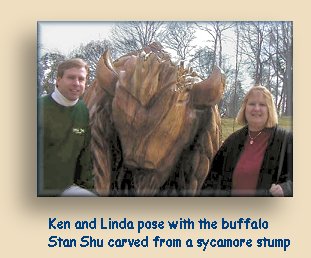 They were planning to have the stump dynamited and
removed when a local artist, Stan Shu, agreed to carve a buffalo out of it.
The result is an amazingly beautiful, almost life-size rendition of a buffalo.
Ken points out, though, that the statue isn't entirely maintenance free.
The stump is not completely dead, and shoots tend to grow out of the beast,
which also shrinks and swells with the climate. Nevertheless, the management
was so impressed with Stan's work that they commissioned him to carve an
eagle-topped totem pole from a living tree next to the mansion. He'll probably
do more works around the distillery from time to time.
They were planning to have the stump dynamited and
removed when a local artist, Stan Shu, agreed to carve a buffalo out of it.
The result is an amazingly beautiful, almost life-size rendition of a buffalo.
Ken points out, though, that the statue isn't entirely maintenance free.
The stump is not completely dead, and shoots tend to grow out of the beast,
which also shrinks and swells with the climate. Nevertheless, the management
was so impressed with Stan's work that they commissioned him to carve an
eagle-topped totem pole from a living tree next to the mansion. He'll probably
do more works around the distillery from time to time.
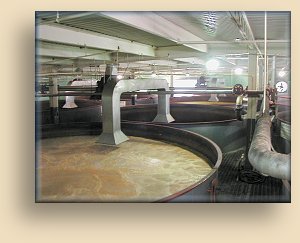 These names live on in Hancock's Reserve, McAfee's
Benchmark, and Leestown. Distilling here began as early as 1787, but became
a commercial enterprise after Benjamin Blanton went off to seek his fortune
in the great California Gold Rush of 1849. Unlike many other "Forty Niners",
he was quite successful. In fact, he struck it rich, didn't gamble or lose
it all in investments, and returned to his home in Kentucky a very wealthy
man. He bought the old Rock Hill farm near Leestown and established a distillery
here sometime between 1857 and 1865. He soon learned that whiskeymaking was
not something he wanted to do, however, and he sold it only four years later.
The man he sold it to named it the Old Fire Copper Distilling Company and
began producing bourbon. OFC remained a very famous brand of bourbon until
it was sold to Schenley (who still produces whiskey under that brand, although
it's Canadian whiskey now and the name has been changed to "Old Fine Canadian").
Only a couple of years later, Col. Edmund Taylor purchased the facility.
These names live on in Hancock's Reserve, McAfee's
Benchmark, and Leestown. Distilling here began as early as 1787, but became
a commercial enterprise after Benjamin Blanton went off to seek his fortune
in the great California Gold Rush of 1849. Unlike many other "Forty Niners",
he was quite successful. In fact, he struck it rich, didn't gamble or lose
it all in investments, and returned to his home in Kentucky a very wealthy
man. He bought the old Rock Hill farm near Leestown and established a distillery
here sometime between 1857 and 1865. He soon learned that whiskeymaking was
not something he wanted to do, however, and he sold it only four years later.
The man he sold it to named it the Old Fire Copper Distilling Company and
began producing bourbon. OFC remained a very famous brand of bourbon until
it was sold to Schenley (who still produces whiskey under that brand, although
it's Canadian whiskey now and the name has been changed to "Old Fine Canadian").
Only a couple of years later, Col. Edmund Taylor purchased the facility.
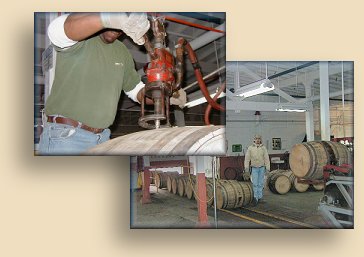 Colonel Taylor owned several distilleries in the
Frankfort-Glenn's Creek area and it was during this period that
he revolutionized the bourbon industry by introducing scientific methods
of ensuring consistency and high quality. Taylor also didn't own the plant
long however, passing ownership on to George T. Stagg (who was principal
owner of the E.H.Taylor, Jr. Co.) in 1886. Stagg added his own brand and
changed the name to the Old Stagg Distillery , but he kept the OFC brand
as well. He also continued to produce
Colonel Taylor owned several distilleries in the
Frankfort-Glenn's Creek area and it was during this period that
he revolutionized the bourbon industry by introducing scientific methods
of ensuring consistency and high quality. Taylor also didn't own the plant
long however, passing ownership on to George T. Stagg (who was principal
owner of the E.H.Taylor, Jr. Co.) in 1886. Stagg added his own brand and
changed the name to the Old Stagg Distillery , but he kept the OFC brand
as well. He also continued to produce
 Old
Taylor whiskey here. Eleven years later, he hired a young man named Albert
B. Blanton, who was the son of founder Benjamin, and he went on to become
the master distiller from 1912 until he retired in 1952. The distillery did
not operate during Prohibition, but was used for warehousing and bottling
of medicinal whiskey. In 1929, the Schenley Corporation bought it, and they
began producing bourbon here in 1933. Sometime much more recently, perhaps
in the eighties, a group of Schenley executives formed their own company
and bought the distillery to operate it on their own. That didn't work out
well and they shortly sold it to Sazerac, a New Orleans-based beverage
corporation. This was in partnership with a Japanese group headed by Yutaka
Takano. The new company was called Age International. Takano's group held
the majority of the ownership until recently, when Sazerac began buying up
more and more until they now hold a majority. This was the point where it
became Buffalo Trace. The relationship between the two owner groups is
competitive at best and sometimes downright adversarial. Thus the uncertainty
of the individual brands.
Old
Taylor whiskey here. Eleven years later, he hired a young man named Albert
B. Blanton, who was the son of founder Benjamin, and he went on to become
the master distiller from 1912 until he retired in 1952. The distillery did
not operate during Prohibition, but was used for warehousing and bottling
of medicinal whiskey. In 1929, the Schenley Corporation bought it, and they
began producing bourbon here in 1933. Sometime much more recently, perhaps
in the eighties, a group of Schenley executives formed their own company
and bought the distillery to operate it on their own. That didn't work out
well and they shortly sold it to Sazerac, a New Orleans-based beverage
corporation. This was in partnership with a Japanese group headed by Yutaka
Takano. The new company was called Age International. Takano's group held
the majority of the ownership until recently, when Sazerac began buying up
more and more until they now hold a majority. This was the point where it
became Buffalo Trace. The relationship between the two owner groups is
competitive at best and sometimes downright adversarial. Thus the uncertainty
of the individual brands.



